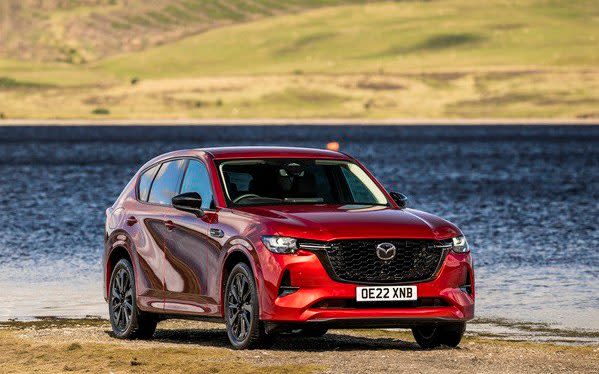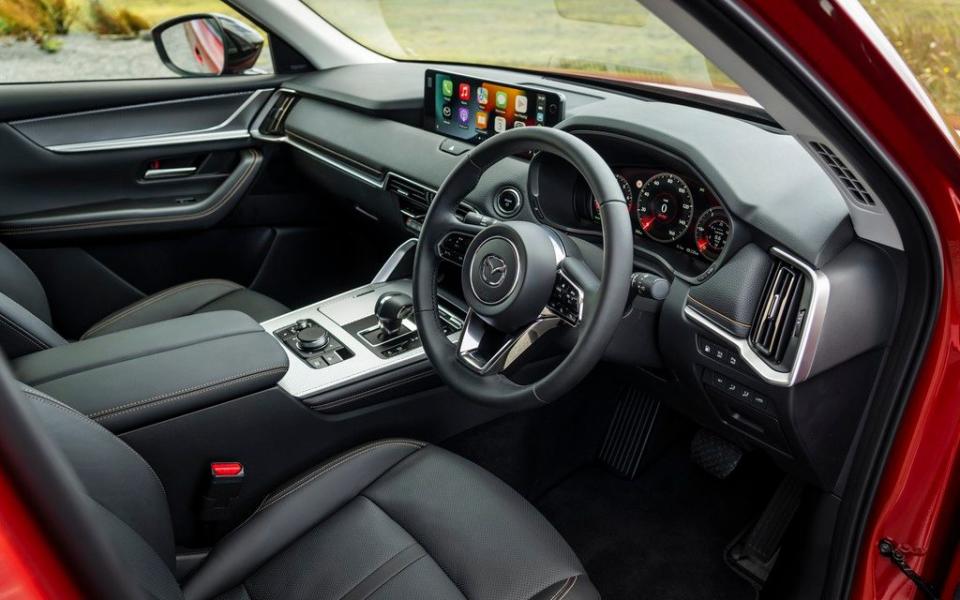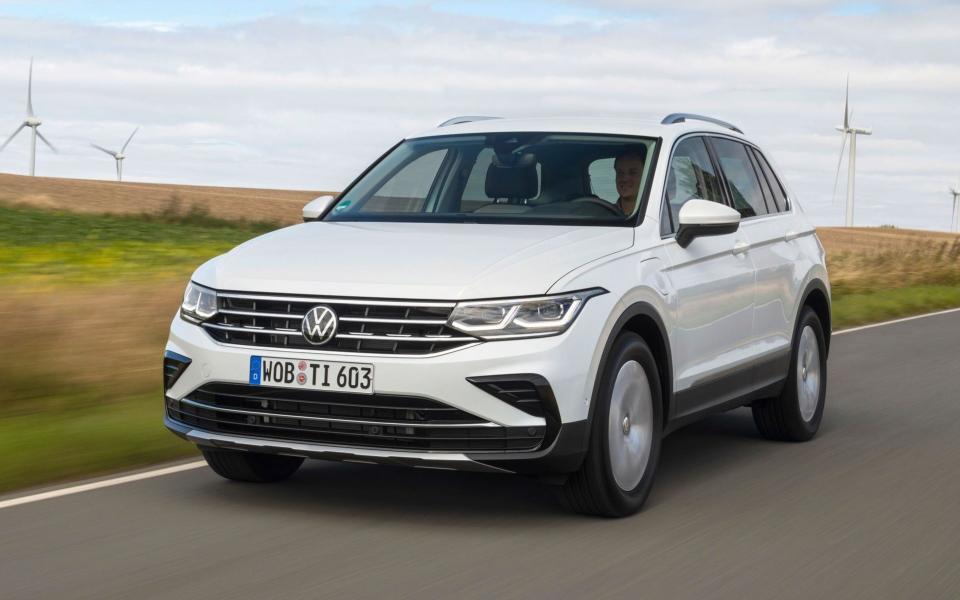Mazda CX-60 review: rivals can’t match its combination of price, power and fuel efficiency

Mazda is thinking big. Once upon a time, its brand image was something akin to a man in purple braces and multi-coloured trousers, blasting an infuriating “Zoom zoom” song in your face and taking every opportunity to shout about its cars being fun to drive. It was the marketing equivalent of a constant forced laugh – not without basis, but toe-curling all the same.
That has all changed. Now, the tagline is “Crafted in Japan”; the Mazda of today is more refined, more subtle – and more open about the fact it wants to be seen as a high-end brand. It wants, in other words, to pull off the sort of transformation Volvo has managed in the last decade, moving from a respected sub-premium car maker to a credible rival to Audi, BMW and Mercedes-Benz.
It’s thinking big, too, in the car with which it’s trying to launch this strategy. It’s called the CX-60 and unsurprisingly it’s an SUV – of course it is, in this day and age. It’s also a plug-in hybrid (PHEV); Mazda’s first, in fact.
Does it have what it takes to carry Mazda’s weighty aspirations?
Pros
Well equipped
Competitively priced
Big boot
Cons
Bouncy ride quality
Juddering transmission
Lifeless steering
Hybrid – and unusually big petrol engines
This plug-in hybrid is the only powertrain the CX-60 will be available with for now, but by next year it’ll be joined by petrol and diesel mild hybrid engines, both of which – very unusually – will be six-cylinder units, in-keeping with Mazda’s trend-bucking dogma of high-capacity, unstressed engines for the sake of fuel efficiency.
You can see this in the petrol engine part of the plug-in hybrid; a 2.5-litre four-cylinder that’s already used in the Mazda6. Here, it’s allied to an electric motor and a 17.8kWh battery to give a total system output of 323bhp and an electric-only range of up to 39 miles, which will probably equate to between 20 and 25 miles in the real world, depending on driving conditions.

The official CO2 emissions are relatively reasonable, at 33g/km – of course, we know this is a bit of a fiction, given how much the test flatters PHEVs. But this is the figure on which company car drivers’ tax is based, and given most PHEVs are now company car specials, it matters in comparison with rivals. And here the CX-60 does pretty well.
On overall company car tax cost, it’s bested by the Volvo XC60 T6 Recharge and Lexus NX450h+, but while its CO2 emissions are pretty average, its relatively low P11D values give it the edge over the Audi Q5 TFSI e, BMW Xe xDrive30e and Mercedes-Benz GLC 300e.
For retail buyers, however, the CX-60 sits in an odd nether-world between those premium rivals and mainstream offerings like the Volkswagen Tiguan eHybrid and Ford Kuga PHEV. That makes it either good value if you’re comparing it with the former, which is what we’ll do given Mazda’s contention that it should sit alongside them, or expensive if you’re looking at it versus the latter.
Specifications
You can have your CX-60 in one of three forms; Exclusive-line gets a heated steering wheel, heated front seats and adaptive cruise control and 18-inch wheels – though you can upgrade to 20-inch wheels, bizarrely, as part of a “Comfort” pack. The Homura trim gets this as standard, along with ventilated front seats, heated outer rear seats, electric steering wheel adjustment and sportier styling.
At the top of the range is the Takumi; this really is the flag-carrier for the new “Crafted by Mazda” slogan. Standard equipment is similar to that of the Homura, but inside there’s intricately hand-stitched fabric coverings for the dashboard and door panels and beautiful pale maple wood trim.

It’s lovely, but one wonders just how practical it will be in a car designed to carry a family; the pale fabric inserts on the rear doors will be a magnet for jam-laden hand prints. If your CX-60 will be a regular child carrier, then, perhaps better to stick with one of the lower trims.
The problem here is that their interiors feel much less special – they’re a sea of dark grey plastic, punctuated only by some needle-thin copper accents, and adorned by some distinctly unconvincing faux aluminium inserts that both feel and look pretty cheap. After the lovely, smooth leather dashboard of the 6 Tourer, or the fabulous cork panels of the MX-30, this all feels just a little bit… well, anticlimactic.
That said, it’s all solid and well put together. What’s more, Mazda has – praise be – renounced the touchscreen and touchpad controls so favoured by rivals. Instead, you get beautifully smooth, slick switchgear that does what you expect it to and doesn’t distract you any more than is necessary; there’s a classy-looking central screen, too, which, unburdened by the need to control all the car’s functions, reacts swiftly and smoothly to inputs via the capstan on the centre console.
That centre console is wide, which means the CX-60 doesn’t feel quite as roomy as you might expect. What’s more, with only two tiny cupholders, a very shallow central cubby, a small glovebox and slim door pockets, there isn’t much space for the usual odds and ends.
Inner space
Having said that, you never feel cramped in the front, and there’s plenty of adjustment, so getting comfortable is a doddle. The back seats are roomy enough, too, with loads of head room and elbow room.While knee room isn’t vast, there’s still more than enough for a tall adult to sit behind another without being cramped.
It’s in the boot, however, that the CX-60 really kicks its rivals into touch, with a whopping 570 litres of space. That’s more than any other plug-in hybrid SUV can offer – 35 litres up on the Lexus and a huge 65 litres more than the Volvo. And while it’s a shame you can’t slide the rear seats fore and aft like you can in a Citroen C5 Hybrid, you can at least alter the angle of the back rests, which allows a modicum of flexibility.

Start the hybrid with a full battery and it’ll run on electric power; you can keep it that way by selecting ‘EV’ from the list of drive modes. Unlike some PHEVs, Mazda’s electric motor is installed in series with the petrol engine – both drive the back axle together, through the gearbox, with power then shared with the front end via a clutch when extra traction is required. That means you don’t get the smooth, slick, EV-esque experience offered by those hybrids that drive the rear axle electrically, independent of the petrol engine’s gearbox.
The gearbox is Mazda’s own automatic, a brand new unit with a multi-plate clutch instead of a torque converter along with an electric starter-generator to spin up the gears to match.
Boxing not so clever
The drivetrain isn’t without fault, mind you; in ‘Normal’ mode, in which the petrol engine and electric motor run together as a conventional hybrid, two of our test cars made a surprisingly loud whining noise under acceleration that sounded like they were fitted with belt-driven superchargers, while the third was prone to occasional graunching noises when pulling away from a standstill.

All three suffered from an odd stutter on occasion, too, usually when the gearbox was confused – for example, when slowing for traffic lights, then using the throttle to trickle up to the car in front – not unlike the transmission shunt you’d get on an older car with a bit of slack in the powertrain and a less-than-healthy idle.
The gearbox is also pretty slow to react if you floor the accelerator pedal in automatic mode, which dulls the shine of the CX-60’s performance, but this is still a fast car – and it feels it from the driver’s seat. In manual mode, ratios are swapped more swiftly, and the gearbox won’t change up or down unless you ask it to, which means you never find yourself calling for the next gear just as it decides to change up and, therefore, changing up twice.
Meanwhile, the relatively large-capacity, naturally-aspirated four-cylinder petrol engine provides a broad swathe of torque that’s topped up by the electric motor, yet there’s also lots of oomph at the top of the rev range, where the electric boost is all done, because the petrol engine is still pretty keen to rev. It delivers a nice, raspy exhaust note, too; in fact, of all the PHEV powertrains you’ll find in any SUV, this is one of the sportiest and most rewarding.
The car itself isn’t one of the most comfortable, however. On the largest 20-inch wheels fitted to all our test cars, the CX-60 feels very jiggly in town, fussing over little bumps and ripples in tarmac. It doesn’t settle at higher speeds on motorways, either, which is a shame because at these velocities the body feels very well planted and settled on its springs, so once you dial out the jitter and fidget you get from expansion gaps and churned-up sections of tarmac, it’s quite a solid and slick cruiser.
Stiff, slow suspension
Once you tackle an undulating back road, however, you really start to find the limitations of the suspension. It’s not actually that the CX-5 is too stiff – there’s a bit of give over smaller bumps, as though there’s a thin layer of rubber between you and the dampers – but the suspension itself feels wooden and dim-witted.

Over lumpier sections the whole car pitches and bucks, its stiffer rear suspension pitching the softer, woollier front down into the next bump, where it’s then forced upward again as the rear dips. Fast compressions elicit a sickening thud as the CX-60 slams into its bump stops before bouncing back up and rebounding with a queasy wobble.
More and more plug-in hybrids these days have adjustable suspension as standard, simply because the demands of controlling their weight while also providing responsive handling are too great, and it feels as though Mazda has tried to make the non-adaptive suspension of the CX-60 do too much. It has to handle all that weight, try to prevent body roll, feel sporty to drive and be comfortable at speed. And, especially when lumbered with 20-inch wheels and commensurately shallow tyre sidewalls, it just can’t do it all.
Around corners, this bounciness becomes a problem as it causes the CX-60 to float over lumps, and if there’s a sharp rut mid-bend the big wheels crash into it. The result is that you find yourself wrestling with the wheel, struggling to hold a line, then as the road straightens again you hesitate to feed in the power too much lest you hit a small crest and find your vertebrae shunting into one another as the CX-60 wafts off the top of it then crunches into the tarmac thereafter.
But on a suitably flat, smooth bit of road you can start to feel where Mazda’s engineers were going with the CX-60; there’s loads of lateral grip, the front end feels really well keyed-into the road, and the clever torque vectoring system will brake one of the rear wheels to help pull the car into a corner, and it makes a clear and noticeable difference when it does this.
The steering is delightfully precise, too, which lends a lovely, crisp feel to the front end, but it also has quite an artificial weighting, and not much in the way of feedback, so you don’t feel keyed into it like you do in… well, most other Mazdas.
The Telegraph verdict
There are problems with the way the CX-60 drives, then, which is a shame because in many other ways it’s very likeable. Viewed in the context of the premium competition it’s good value – indeed, none of its rivals can match its combination of price, power and fuel efficiency. It’s pretty affordable as a company car, too, and while the interior lacks sparkle, it’s functional, practical and very easy to get along with.
If only Mazda had dialled out that pitching, bouncing character of the suspension, this would be a very recommendable car. Perhaps, then, the remedy is to pick the Exclusive version, with its 18-inch wheels, although you miss out on some very nice-to-have equipment if you do so. We’ll be testing one in due course, to see if it can earn the CX-60 an extra star.
Crafted in Japan it may be but, on British roads, it simply can’t quite live with the best of its premium plug-in rivals.
The facts
On test: Mazda CX-60 2.5 e-Skyactiv PHEV Homura
Body style: five-door SUV
On sale: now
How much? £46,700 on the road (range from £43,950)
How fast? 124mph, 0-62mph in 5.8sec
How economical? 188.3mpg (WLTP Combined)
Engine & gearbox: 2,488cc four-cylinder petrol engine, eight-speed automatic gearbox, four-wheel drive
Electric powertrain: AC motor with 17.8kWh battery, 7.2kW on-board charger, Type 2 charging socket
Electric range: 39 miles
Maximum power/torque: 323bhp/369lb ft
CO2 emissions: 33g/km (WLTP Combined)
VED: £0 first year, £510 next five years, then £155
Warranty: 3 years / 60,000 miles
Spare wheel as standard: no (not available)
The rivals
Volvo XC60 T6 Recharge Plus
345bhp, 282.5mpg, £61,235 on the road

The XC60 in this form manages to be both more powerful yet also more fuel-efficient than the Mazda, and thrown into the bargain, it also gets a longer electric range of 48 miles. It’s also just as well equipped, and feels more special inside – but of course, you pay for all this with a considerably higher starting price. That said, if you’re a company car user-chooser, the low CO2 emissions will actually render this the cheaper option in terms of your tax liability.
BMW X3 xDrive30e xLine
288bhp, 134.5mpg, £53,730 on the road

By comparison with the Mazda, the X3’s stats look rather disappointing – it’s more expensive to buy (and to tax as a company car), less fuel efficient, nowhere near as quick and not quite as well equipped. Where it does score, however, is on the driving experience – it both rides more comfortably and handles more intuitively than the Mazda.
Volkswagen Tiguan 1.4 eHybrid 245 R-Line
242bhp, 166.2mpg, £40,075 on the road

Everything the Tiguan does, it does in a fairly average way. It’s competent but unremarkable in so many areas, and that really is its biggest strength as well as its biggest weakness. It means that while it isn’t as roomy or as fast as the Mazda, it’s also more comfortable, cheaper to buy, and cheaper to tax as a company car. And given the cost of living crisis, that might be enough to tip the balance in its favour.
For new and used buying guides, tips and expert advice, visit our Car Advice section, or sign up to the Telegraph Cars newsletter here and to join the Telegraph Motoring Club Facebook group click here

 Yahoo Movies
Yahoo Movies 
